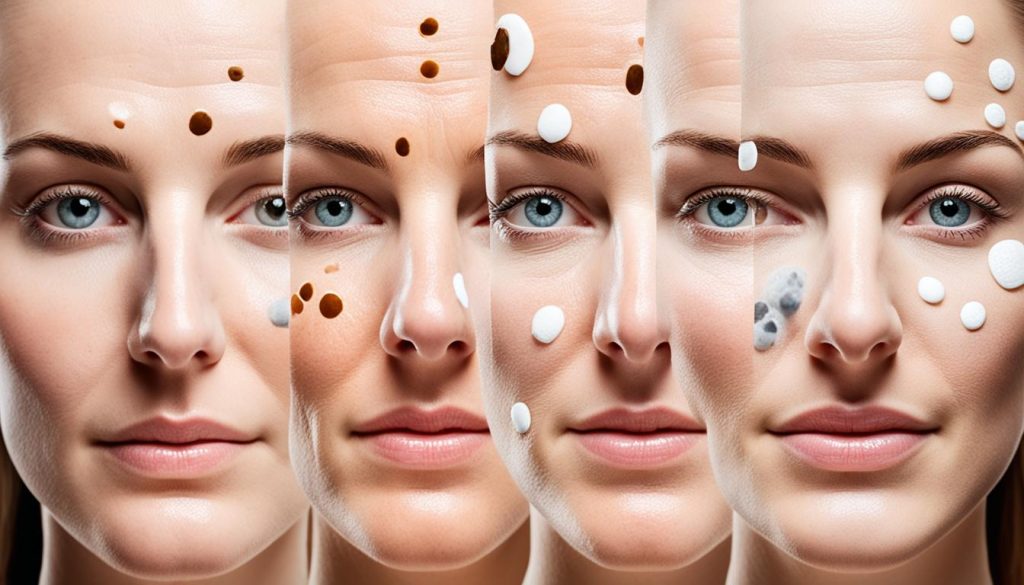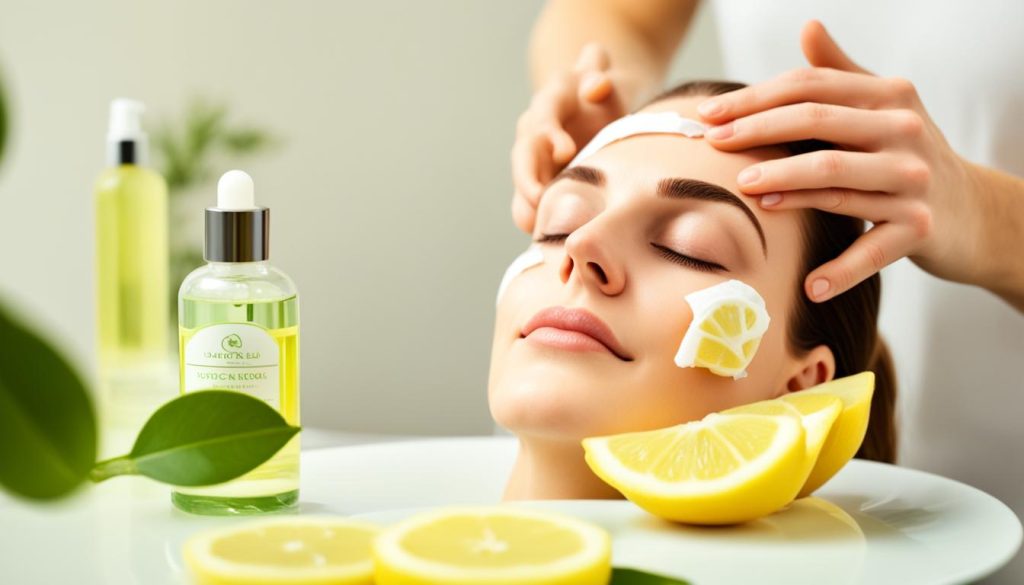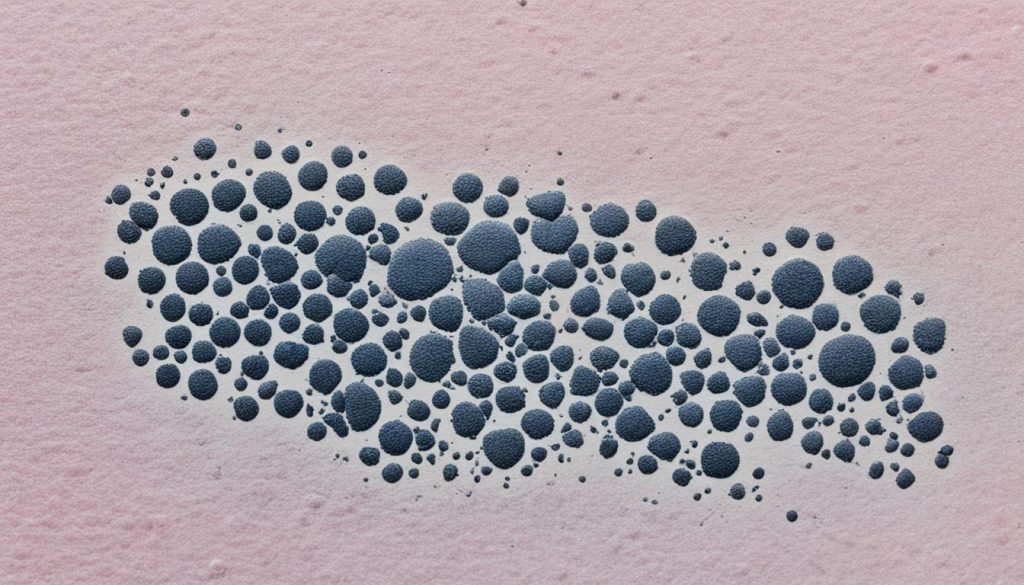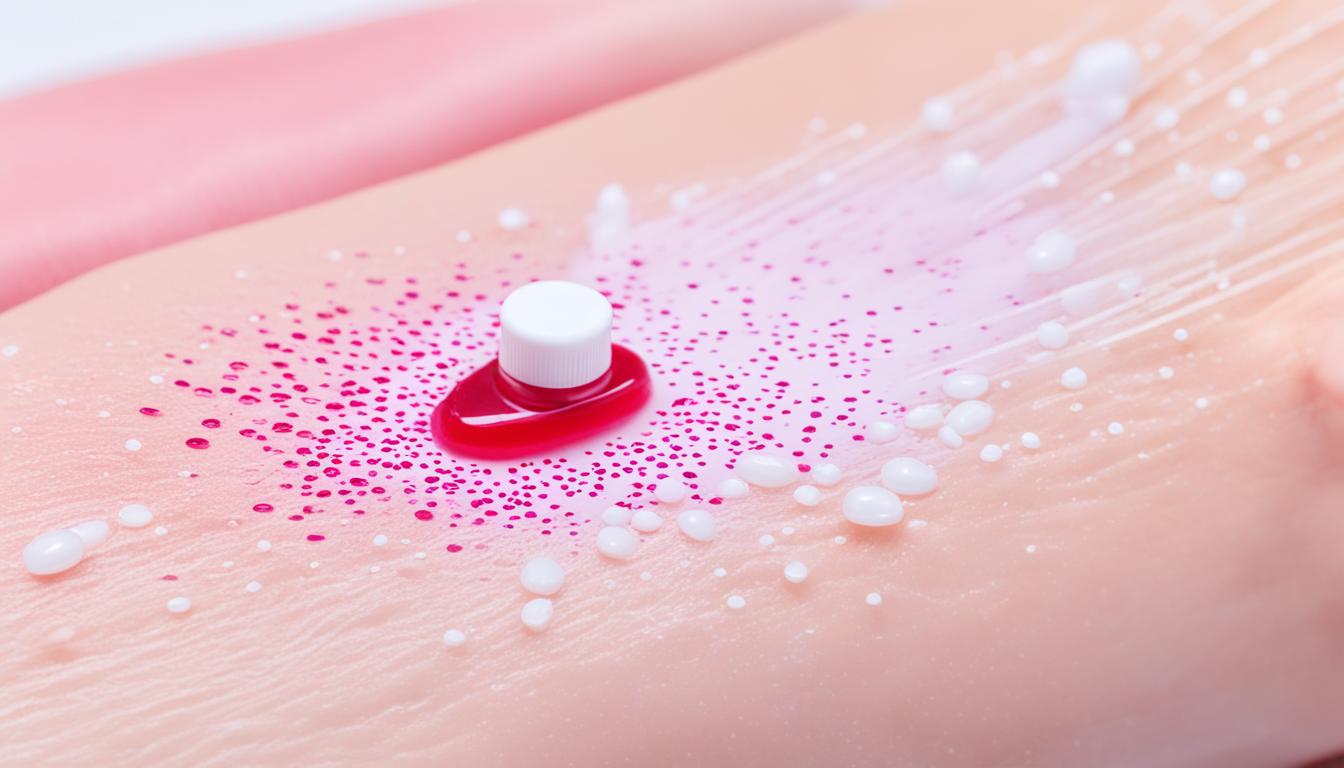Spots are a common skin concern and can be frustrating to deal with. Understanding the science behind spots is the first step towards treating and preventing them. Spots develop when pores become clogged and inflamed, leading to inflammation. There are different types of spots, including blackheads, whiteheads, pustules, papules, nodules, and cysts.
The main causes of spots include high-glycemic foods, hormonal changes, using harsh skincare products, and environmental factors. Face mapping can also help identify the possible causes of spots on different areas of the face.
Getting rid of spots and achieving clear skin require a combination of spot treatment and prevention. In the following sections, we will explore the types of spots and their causes, as well as effective prevention and treatment strategies for clear and spot-free skin.
Types of Spots and Their Causes
The development of spots on the skin can be attributed to various factors. Understanding the different types of spots and their causes is crucial in effectively treating and preventing them. Let’s explore the six main types of spots and what leads to their occurrence.
1. Blackheads
Blackheads occur when the inner lining of the hair follicle produces excess sebum and dead skin cells. The mixture oxidizes, giving rise to the characteristic black color. Common in individuals with oily skin, blackheads appear often on the nose, chin, and forehead.
2. Whiteheads
Unlike blackheads, whiteheads are completely sealed pores that become inflamed. They occur due to the accumulation of dead skin cells, sebum, and bacteria. Whiteheads often appear as small, white or flesh-colored bumps on the skin’s surface.
3. Pustules
Pustules are small red bumps with a white or yellowish center. They are caused by the build-up of pus, dead skin cells, and bacteria. Pustules are often tender and can be a result of inflammatory acne.
4. Papules
Papules are sore, red bumps that appear on the skin’s surface. These raised areas are caused by inflammation and result from blocked hair follicles. Papules are typically smaller in size and may be sensitive to touch.
5. Nodules
Nodules are hard lumps that develop deep under the skin’s surface. They occur when the blocked pores become further inflamed and enlarged, leading to a painful bump. Nodules often require medical intervention for treatment.
6. Cysts
Cysts are large, painful, pus-filled lumps that can cause considerable discomfort. They are the most severe form of acne and can lead to scarring if not treated properly. Cysts occur when the blocked and infected pores rupture deep within the skin.
The causes of spots range from hormonal changes and high-glycemic foods to using harsh skincare products and environmental factors. It’s also worth noting that genetics can play a role in spot development. Understanding the causes behind each type of spot can help guide treatment and prevention strategies to achieve clearer, healthier skin.

How to Get Rid of Spots?
A good skincare routine is essential for spot prevention and treatment. To keep your skin clear and spot-free, follow these tips:
Cleanse Twice a Day
Start by cleansing your face twice a day using a mild cleanser. This helps remove excess oil, dirt, and impurities that can clog your pores and lead to spots.
Use Warm Water for Cleansing
When cleansing your face, use warm water to open up your pores. This allows for a deeper cleanse and helps to remove any trapped debris or bacteria.
Exfoliate Regularly
Regular exfoliation helps to remove dead skin cells, unclog pores, and prevent the formation of spots. Use a gentle exfoliant with small exfoliating beads to avoid irritating your skin.
Moisturize Daily
After cleansing and exfoliating, apply a lightweight moisturizer to keep your skin hydrated. This helps maintain a healthy skin barrier and prevents excessive oil production.
Protect Your Skin from the Sun
Sun exposure can trigger spots and worsen their appearance. Apply a broad-spectrum sunscreen with at least SPF 30 every day, even on cloudy days.
Lead a Healthy Lifestyle
Engage in regular exercise, manage stress effectively, and maintain a healthy diet. A balanced lifestyle promotes overall skin health and helps prevent spots from forming.
Avoid Popping Spots
Resist the temptation to pop or squeeze your spots. This can lead to inflammation, scarring, and further breakouts. Instead, treat spots with spot treatments or consult a dermatologist for professional guidance.
Avoid Overdrying and Pore-Clogging Makeup
Avoid using harsh skincare products that can dry out your skin excessively. Similarly, opt for non-comedogenic and oil-free makeup products to prevent pore clogging.
Following these tips, along with consulting with a dermatologist for personalized advice, can help you effectively prevent and treat spots for a healthier-looking complexion.

Why DIY Home Remedies Can Be Ineffective?
Dark spots, also known as hyperpigmentation, can be challenging to eliminate. Many people turn to DIY home remedies in an attempt to fade these stubborn marks. However, while toothpaste, lemon juice, and soda are often touted as effective treatments, they can actually be too harsh and damaging to the skin. It’s important to understand the limitations of these remedies and seek safer alternatives for at-home dark spot treatments.
Dermatologists recommend incorporating gentle yet effective ingredients into your skincare routine to address dark spots and improve overall skin tone and texture. Some of the recommended at-home treatments include:
- Vitamin C serums: These serums, packed with antioxidants, help reduce hyperpigmentation and promote a more even complexion.
- Gentle exfoliants: Exfoliating regularly can slough off dead skin cells and promote cell turnover, which can aid in fading dark spots.
- Retinol products: Retinol, derived from vitamin A, stimulates collagen production and accelerates skin cell turnover, leading to a brighter complexion.
- Sunscreen protection: Sun exposure can worsen dark spots, so it’s crucial to wear sunscreen with a high SPF to prevent further pigmentation.
By incorporating these at-home treatments, you can take proactive steps towards reducing dark spots and achieving a more radiant complexion. However, it’s important to note that everyone’s skin is unique, and results may vary. If you experience signs of skin irritation or worsening of the dark spots, it’s recommended to consult a dermatologist for personalized advice and treatment options.

Remember, patience is key when it comes to treating dark spots. Consistency with your skincare routine and incorporating professional advice can help you reach your goals of a clearer, more spot-free complexion.
Conclusion
After understanding the different types and causes of spots, it becomes clear that achieving a spot-free complexion requires a holistic approach. It begins with adopting a proper skincare routine that includes cleansing, exfoliating, and moisturizing. Additionally, it’s crucial to protect the skin from the harmful effects of the sun by consistently applying sunscreen.
Avoiding harsh skincare products that can irritate the skin is also essential in preventing spots. Instead, opt for antioxidant-rich products that help promote a healthier skin barrier. Gentle exfoliants can aid in fading existing spots, while retinol treatments can improve overall skin texture.
While following these recommendations can assist in achieving clear skin, it’s always advisable to consult a dermatologist for personalized advice and treatment options tailored to individual needs. Dermatologists can provide expert guidance and recommend suitable skincare products and procedures.
By incorporating these strategies into your daily routine, you can take significant steps towards achieving a spot-free complexion and maintaining healthier-looking skin in the long run. With the right skincare practices and professional guidance, you can confidently say goodbye to spots and hello to clear, beautiful skin.
FAQs
How can I prevent and treat spots?
To prevent spots, maintain a good skincare routine, use sunscreen protection, and avoid harsh products. Leading a healthy lifestyle, including regular exercise, stress management, and a healthy diet, can also help. To treat spots, incorporate antioxidant-rich products, gentle exfoliants, and retinol treatments. Consult a dermatologist for personalized advice and treatment options.
How can I achieve clear skin and a spot-free complexion?
Achieving clear skin and a spot-free complexion requires a combination of proper skincare, sun protection, and healthy lifestyle habits. Understanding the different types and causes of spots is the first step. Follow a skincare routine, use sunscreen, and avoid harsh products. Incorporate antioxidant-rich products and treatments. Consult a dermatologist for personalized advice.

